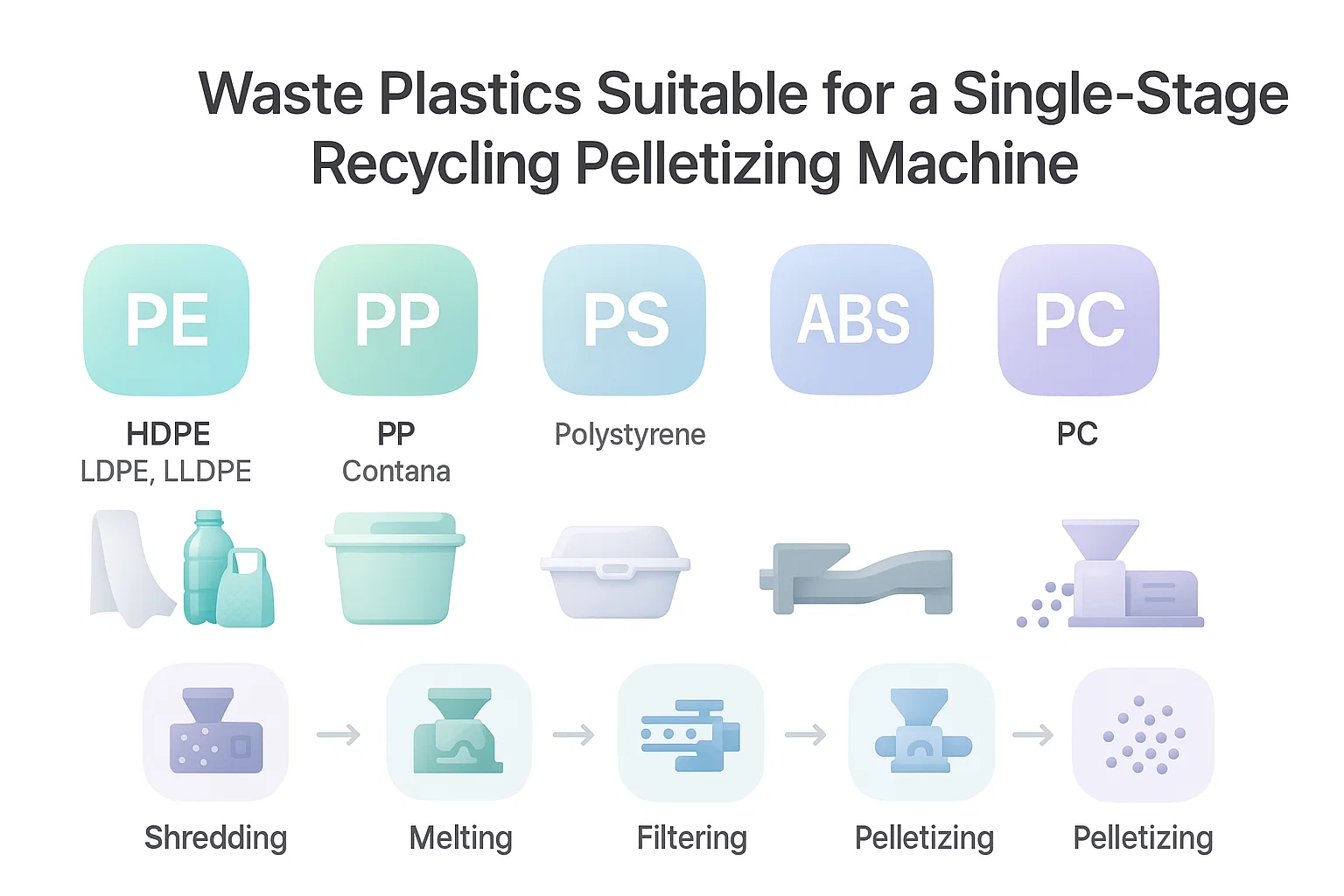Single-stage recycling pelletizing machines are widely used in the plastic recycling industry due to their efficiency and versatility. These machines integrate plastic melting and pelletizing in a single process, making them ideal for handling various types of plastic waste—especially polyolefins like PE and PP.
Suitable Plastic Types
Single-stage pelletizers are primarily designed for processing clean, dry, and relatively uncontaminated plastic materials. Commonly accepted types include:
1. Polyethylene (PE)
This includes:
- HDPE (High-Density Polyethylene): Found in bottles, containers, and industrial scraps
- LDPE (Low-Density Polyethylene): Used in plastic bags, shrink wraps, and agricultural films
- LLDPE (Linear Low-Density Polyethylene): Typically used for stretch films and packaging materials
2. Polypropylene (PP)
Typical PP waste includes:
- Woven bags, raffia ropes, and packaging sacks
- BOPP/CPP films from industrial packaging
- Nonwoven fabrics and lightweight plastic sheets
3. Other Thermoplastics (with proper configuration)
- Polystyrene (PS) and High-Impact Polystyrene (HIPS)
- Acrylonitrile Butadiene Styrene (ABS)
- Polycarbonate (PC)
- Select specialty plastics such as EVA, PMMA, or PA, assuming they are pre-cleaned and homogeneous
Material Forms and Sources
These machines can handle a wide range of input forms:
- Post-industrial scraps (e.g., offcuts, film trimmings)
- Post-consumer waste (e.g., used bags, containers)
- Soft materials like films and flexible packaging
- Rigid plastics such as bottles, buckets, and crates
- Pre-processed foam or composite materials, if properly sorted and prepared
Processing Characteristics
Single-stage pelletizing systems are characterized by:
- Integrated design: Combines melting, degassing, filtering, and pelletizing in one continuous process
- Input requirements: Preferably dry, clean, and shredded materials
- Production capacity: Medium-scale output, typically ranging from 100–800 kg/h
- Pelletizing methods: Options include hot die face, strand, or underwater pelletizing, selected based on material type and application
These systems are especially suitable for:
- Film, sheet, and fiber materials
- Applications where pellet surface gloss is not critical
- Reprocessing materials with minor levels of ink, dust, or moisture (with degassing and filtration)
Considerations
While single-stage systems offer excellent flexibility, certain materials require additional attention:
- Highly contaminated materials (e.g., with oil, heavy printing, or mixed composition) should be pre-washed and dried
- High-glass-fiber content engineering plastics are better handled with a twin-stage pelletizing line, which provides improved filtration and material refinement
Conclusion
Single-stage recycling pelletizing machines are a robust solution for processing a wide range of plastic waste, with a focus on PE and PP materials. Their ability to handle both soft and rigid plastics, coupled with streamlined operation, makes them ideal for both post-industrial and post-consumer recycling needs—provided that the feedstock is properly prepared and free of heavy contamination.

